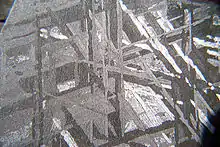M-type asteroid
M-type asteroids are asteroids of partially known composition; they are moderately bright (albedo 0.1–0.2). Some, but not all, are made of nickel–iron, either pure or mixed with small amounts of stone. These are thought to be pieces of the metallic core of differentiated asteroids that were fragmented by impacts, and are thought to be the source of iron meteorites. M-type asteroids are the third most common asteroid type.

There are also M-types whose composition is uncertain. For example, 22 Kalliope has an accurately known density that is far too low for a solid metallic object or even a metal rubble pile: a rubble pile of iron-nickel metal would need about 70% porosity which is inconsistent with packing considerations. 22 Kalliope and 21 Lutetia have features in their spectra which appear to indicate the presence of hydration minerals[2] and silicates,[3] anomalously low radar albedos inconsistent with a metallic surface,[4] as well as characteristics more in common with C-type asteroids. A variety of other M-type asteroids do not fit well into a metallic body picture.
M-type spectra are flat to reddish and usually devoid of large features, although subtle absorption features longward of 0.75 μm and shortward of 0.55 μm are sometimes present.[5]
Observational history
16 Psyche is the largest M-type asteroid, and does appear to be metallic. The Psyche spacecraft is slated to visit 16 Psyche. 21 Lutetia, an anomalous, probably non-metallic body, was the first M-type asteroid to be imaged by a spacecraft when the Rosetta space probe visited it on July 10, 2010. Another M-type asteroid, 216 Kleopatra, was imaged by radar by the Arecibo Observatory in Puerto Rico, and has a dog bone-like shape.[6]
M-type was one of three basic asteroid types in early classifications (the others being the S- and C-types), and was thought to indicate a metallic body.
See also
References
- Amos, Jonathan (January 31, 2016). "Hunt for Antarctica's 'lost meteorites'". BBC News. Retrieved January 15, 2018.
- A.S. Rivkin; et al. (2000). "The nature of M-class asteroids from 3-micron observations". Icarus. 145 (2): 351. Bibcode:2000Icar..145..351R. doi:10.1006/icar.2000.6354.
- D.F. Lupishko; et al. (1982). "UBV photometry of the M-type asteroids 16 Psyche and 22 Kalliope". Solar System Research. 16: 75. Bibcode:1982AVest..16..101L.
- C. Magri; et al. (2001). "Radar constraints on asteroid regolith compositions using 433 Eros as ground truth". Meteoritics & Planetary Science. 36 (12): 1697. Bibcode:2001M&PS...36.1697M. doi:10.1111/j.1945-5100.2001.tb01857.x.
- S.J. Bus and R.P. Binzel (2002). "Phase II of the Small Main-belt Asteroid Spectroscopy Survey: A feature-based taxonomy". Icarus. 158 (1): 146–177. Bibcode:2002Icar..158..146B. doi:10.1006/icar.2002.6856.
- Shepard, Michael K.; Timerson, Bradley; Scheeres, Daniel J.; Benner, Lance A.M.; Giorgini, Jon D.; Howell, Ellen S.; Magri, Christopher; Nolan, Michael C.; Springmann, Alessondra; Taylor, Patrick A.; Virkki, Anne (2018). "A revised shape model of asteroid (216) Kleopatra". Icarus. 311: 197–209. Bibcode:2018Icar..311..197S. doi:10.1016/j.icarus.2018.04.002.